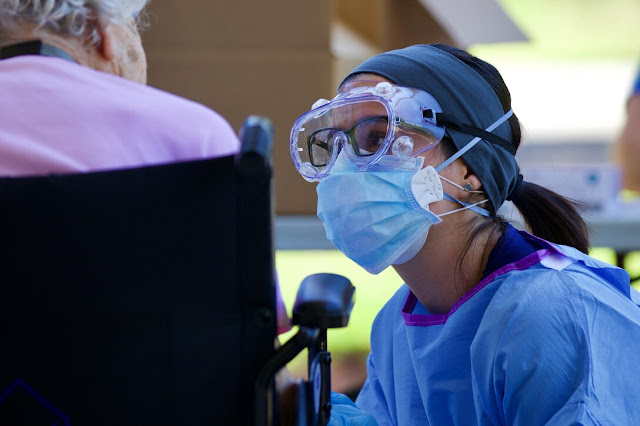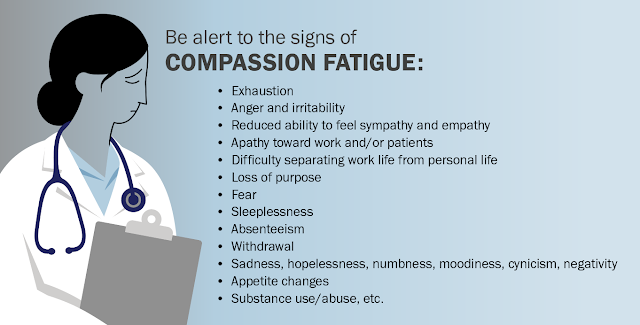Compassion Fatigue: When Helping Hurts USU Students
By Vivian Mason
Deep within the COVID fight is a fatigue, an emotional tsunami in the hearts and minds of many frontline healthcare workers. Hidden behind layers of personal protective equipment are dedicated professionals with their own personal worries and collective traumas. These healthcare workers remain faithful in their oath to administer compassionate care, fighting to save critical COVID patients, saying goodbye to patients who are separated from their family members, and having to bid farewell to their own families because they can never be quite sure when they will return home. Added fear, anxiety, stress, physical distancing, and uncertainty can make it all overwhelming and exhausting.
These feelings and issues take their toll on people’s mental health and can cause them to run on empty for a while. Emotional capacities change; there’s hardly time to recharge. There’s a high cost to caring, and it comes in the form of compassion fatigue.
Medical literature can’t quite settle on one definition for compassion fatigue. It can occur in healthcare professionals and caregivers who are committed to self-sacrifice and/or prolonged exposure while treating/taking care of patients who have been exposed to pain and trauma over an extended period of time. The caregivers can end up emotionally exhausted from the act of continuously caring and giving, thus resulting in their not being able to care for or empathize with another’s suffering. Caregivers can feel indifferent and often helpless. Many experts consider this a kind of secondary posttraumatic stress.
“It really points to fatigue….physically, emotionally, and spiritually,” explains U.S. Air Force Lt. Col. Regina Owen, program director and assistant professor of the Psychiatric Mental Health Nurse Practitioner Program at USU’s Daniel K. Inouye Graduate School of Nursing. “You’re tired, exhausted, and feel helpless. That feeling of helplessness persists even after doing everything possible to help your patients. Eventually, you forget what you’re doing and why you’re doing it, often leading to feeling like you are failing. There’re a lot of psychological and emotional components. Yet, oftentimes, compassion fatigue can still be difficult to recognize.”
 |
| "Almost everything will work again if you unplug it for a few minutes... including you." [Quote by Annie Lamott] [Image credit: Army Sgt. Michael Baltz] |
Compassion fatigue is often compared to burnout; however, burnout occurs over a period of time whereas compassion fatigue has a more rapid onset. Compassion fatigue is characterized by deep physical and emotional exhaustion, as well as by a pronounced change in the caregiver’s ability to feel empathy. Even though it’s not recognized as a mental or psychiatric disorder, compassion fatigue is real, and the term was first used in 1995 by Dr. Charles Figley, director of the Tulane Traumatology Institute at Tulane University.
So how does compassion fatigue relate to students at the Uniformed Services University of the Health Sciences (USU)? They will be entering a work world filled with COVID-related challenges, changes, and consequences.
“Compassion fatigue is an occupational hazard,” Owen continues. “Our medical and graduate nursing students are juggling their school workloads, stressful work environments, long hours, and challenging rotations, in addition to their military obligation. That’s a great deal of stress. Many of our graduate nursing students have been deployed at their previous assignments, and they may be experiencing different behavioral stressors.”
Various studies have also shown that a decline in empathy occurs during the clinical experience years of medical and graduate nursing students. What can result are feelings of depersonalization, emotional exhaustion, and decreased effectiveness that can cause depression, anxiety, and other kinds of psychological distress. Self-empathy is a way to improve the well-being of medical and graduate nursing students so that they can eventually take better care of their patients. Owen believes that the study and practice of self-empathy should be integrated into medical/nursing school training so it becomes part of their daily lives.
At USU, medical students have a well-being program in place with the Student Wellness Advisory Board (SWAB). SWAB also ensures student awareness and oversight of wellness activities on campus, and partners with experts across the USU community to provide activities and initiatives to address well-being. In addition, the Learning Resource Center (LRC) at USU has developed the WELLrc, a wellness initiative that consists of a series of wellness events that are designed to connect, support, and sustain the USU community. This program works in partnership with SWAB to ensure that students have a wealth of access to vital resources.
“If we give students the tools and can train them when they’re beginning their new profession, we can equip them to acknowledge and recognize signs of compassion fatigue and possibly prevent it from occurring down the road,” said Owen. “We need to support and encourage students to have open and honest discussion with their peers and leaders about the warning signs. It continues to be very problematic, and ensuring that various interventions are available is vital.”
The first step to avoid compassion fatigue is awareness. Acknowledge that it exists and is possible. Compassion fatigue is treatable, providing we recognize the signs and symptoms early and institute appropriate intervention. The second step is to take care of yourself and your emotional needs first. Everyone loses (patients, spouses, children, family, etc.) when you’re tapped out at school/work and at home.
 |
| Graphic courtesy of Sofia Echelmeyer, USU |
Much of prevention includes wellness and self-care such as developing support systems personally and professionally, exercising and eating properly, prioritizing activities unrelated to work, and practicing mindfulness (a state of active, open attention on the present moment).
“Studies support that simply providing students with a mindfulness activity to manage stress can have a positive impact. It’s important for students to identify various behaviors that can lead to feeling revived and replenished. If they’re unable to develop these behaviors over time, that’s when students start to struggle. Symptoms start to show. They isolate themselves and keep it all in. Then, it can get worse. If we can provide an environment for open discussion and provide interventions and tools to deal with this occupational hazard, then that would be a tremendous benefit.”
Owen also recommends encouraging a supportive work environment, maintaining a work/life balance, determining personal coping strategies, taking breaks and timeouts, utilizing onsite counseling, developing a buddy system, using personal journaling, offering collective ways to share difficult experiences, and forming support groups.
“Then, you can recognize the connections between your feelings, thoughts, and behaviors, which immediately guide you to do something that benefits your well-being. It’s a simple, but complex idea,” Owen added. “Be aware of what contributes to your stress levels. Make sure you balance your time caring for others with time spent caring for yourself and feeding your soul.”
Medical and graduate nursing students are now, more than ever, under a tremendous amount of daily pressure with plenty of demands on their time. Compassion fatigue attacks at the very core of what brought them into medicine and nursing in the first place: empathy and compassion for others and the desire to help. Regardless, it’s absolutely necessary for them to take time for themselves to recover from stress and burnout. Remembering to incorporate self-care and self-empathy into their daily schedules will enable students (and seasoned professionals, too!) to remain engaged with their selected profession and not run on empty so often.

![[Image credit: U.S. Navy photo by Petty Officer 1st Class Ernest R. Scott] A man with a stethoscope comforts a patient.](https://1.bp.blogspot.com/-c6i42bdHRDo/YGr2idL7uwI/AAAAAAAABAA/QCSE_4BiTaA9MVBi7e30eQQN6wt5hO0YgCLcBGAsYHQ/w640-h428/Photo%2B6.jpg)



